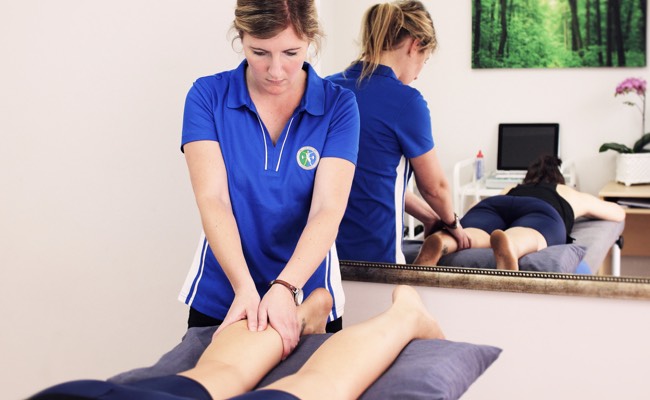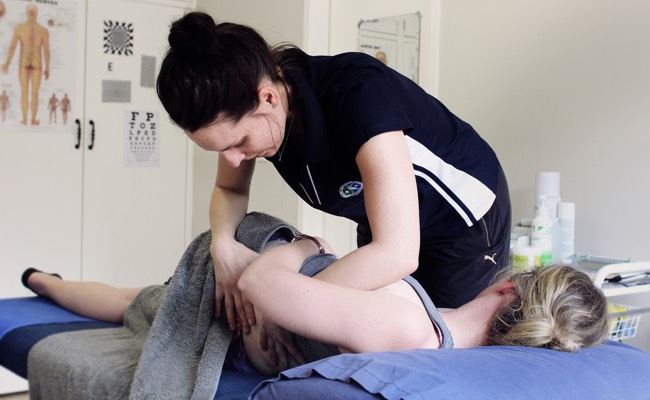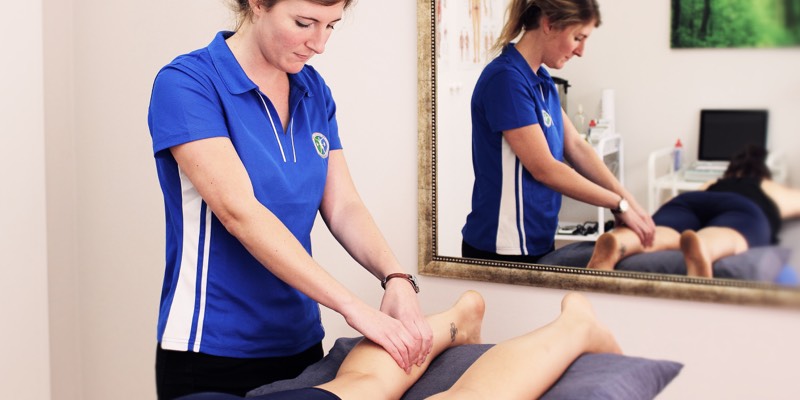Massage therapy is a hands-on manipulation of soft tissue such as your muscles, ligaments, tendons, fascia and skin. Physiological effects can help both stop muscle spasm or stimulate to enhance muscle function.
The soft tissues of our body (muscles, tendons, and fascia) are organized in layers that need to slide and glide over one another for movement to occur normally. Lack of this ‘sliding and gliding’ can lead to restriction of movement in a body region, with the development of harmful altered movement patterns to compensate for this restriction.


Soft tissue mobilization
Soft tissue mobilisation (STM) is used to break up inelastic or fibrous muscle tissue (called ‘adhesions’) such as scar tissue. This technique is commonly applied to the muscles surrounding joints, and consists of rhythmic stretching and deep pressure. The therapist will localize the area of greatest tissue restriction through layer-by-layer assessment. Once identified, these restrictions can be mobilized with a wide variety of techniques which help ‘loosen up’ these restrictions, reducing the need for compensatory movements.
Restriction in the ‘slide & glide’ of muscles over one another are referred to as ‘Trigger points’(muscle knots) that makes a big impact on how effective the muscle can contract and has an even greater effect on the movement pattern. Its like Spiderman having a knot in his suit, he will not move as easily.
Massage is in essence: Myofascial mobilization, which means to manually restore movement to a stiff or immobile structure.
Sports massage
This involves deep tissue trigger point release. It could be fairly painful, but the results are rewarding.
We use our anatomy knowledge to manipulate and mobilize soft tissue like muscle, fascia, nerve, joint, etc. We use a combination of different techniques like trigger point therapy, myofascial release and deep friction to alter movement patterns. Benefits include boosting of the immune systems, blood pressure, circulation, muscle tone, joint movement to achieve bio-mechanical efficiency.
What to expect from a Sports Massage?
This type of massage is an advanced massage technique that uses scientifically proven, therapeutic techniques to use physiological, mechanical and psychological responses. These techniques can be applied to treat minor soft tissue (ligament, tendon, muscle, fascia) injuries, removing scar tissue, prevent the occurrence of injuries by taking care of the micro traumas (knots, adhesions, secondary tension) all athletes experience on a daily basis and it will also enhance performance by properly preparing and relaxing the muscles pre- and post-event.
The main aim of this type of treatment is to ensure optimal performance.
Although some techniques that may be used will cause a certain degree of discomfort (in order to create the physiological effects) your pain threshold be taken into consideration at all times.
Get the help you really need
Medical professionals that care about you
Benefits of a Deep tissue, Sports Massage
Research has repeatedly proved the mechanical & physiological changes that occur after a deep tissue massage.
- Relief of chronic muscle tension
- Encourages deep relaxation (Post-event)
- Postural improvement
- Increased flexibility (Assists with the mobilization of joints)
- Loosen muscle tissues by eliminating knots, adhesions and scar tissue
- formation
- Improve blood circulation
- Encourage the removal of toxins from muscles
- Restores normal length to muscles & connective tissues
- Improves muscle performance
- Ensure fascial tissues’ normal gliding
- Relieves Myofascial Trigger Points
Effects of Massage
- Relieve muscle tension
- correct movement patterns
- Improve range of movement
- Activate muscles
- Improve joint range
- Increase blood flow to tissue
- Loosening of muscle tightness
- Desensitize nerves
- Accelerate healing of tissue
- Improve immune system functions
- Improve range of motion and muscle flexibility
- Shorten recovery time
- Maximise the supply of nutrients and oxygen to tissue
- Eliminate the metabolic by-products of exercise
If your pain hasn’t subsided in 3 days, give us a call so we can have a look and determine the damage.
Get to the root cause of your problem
Our team of experts guide you to heal
The difference between a Swedish massage, Thai massage & Sports Massage
So, many beauty salons offer a wide range of massages but what’s the difference?
The main differences between a Swedish massage, Thai massage and Remedial Sports Massage is all about the goal that needs to be achieved. Understanding ‘what needs to be done’ is guided by ‘what we are trying to achieve’.

Muscle Energy Techniques
Muscle energy techniques (MET’S) are designed to move restricted joints and lengthen shortened muscles. This is achieved by the patient contracting his/her muscles against the practitioner from a precise position into a specific direction. After a 3-5 second contraction, the patient will relax the muscles and the therapist will take the joint to its new barrier. This is repeated several times.
This technique is considered an active movement as opposed to a passive movement where the therapist does all the hard work.(such as joint mobilizations). Muscle energy techniques are generally tolerated well by the patient and do not stress the joint.
Massage techniques
- Stroking is performed with the whole hand or fingers. It comprises the usage of relaxed hand over the patient’s skin with a rhythm and pressure that produce a relaxing effect.
- Effleurage is performed by spreading and moving the hands with pressure and speed, to gain relaxation and lymph drainage.
- Kneading involves compression and release of the area to be treated.
- Picking up involves lifting up of tissue from underlying bone, releasing it after squeezing it.
- Wringing technique lifts up the tissue and applies a twist to stretch the myofascia.
- Friction is a small movement applied with thumb or finger where pressure is applied from superficial to depth of the tissue.
- Hacking is performed with extended forearm and striking the skin using the side of the hand.
- Clapping is done by striking the skin with cupped hands.
- Shaking and vibration involves gentle strokes of shakes and vibrations respectively.

